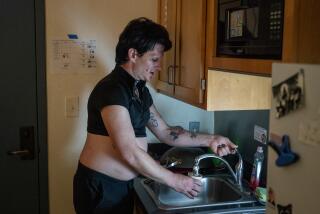Power of Citizen Action Against Crime Stressed at Symposium : Thousand Oaks: Residents eagerly exchange ideas about how to make third-safest city in America safer.
- Share via
Blending cutting-edge computers and old-fashioned brainstorming in the city’s first Crime Symposium, Thousand Oaks citizens said Saturday that volunteer crime-fighters can help make the third-safest city in America even safer.
People from Thousand Oaks’ City Hall, schools, police force and tree-lined neighborhoods met at Westlake High School to explore ways of confronting crime in Thousand Oaks before it grows beyond their ability to control it.
Before breaking into study groups to focus on crime-fighting ideas, the 120 symposium attendees heard police and civic leaders stress that the power to stop crime lies in the hands of citizens.
Rising youth violence and a rash of post-earthquake robberies along the Ventura Freeway have threatened the safety of Thousand Oaks, even though 1993 FBI statistics ranked it America’s third-safest city, said Chief Deputy Robert Brooks of the Ventura County Sheriff’s Department.
“Twelve percent of violent crime in Thousand Oaks is attributable to gangs,” warned Brooks. “The age of offenders is dropping. They’re becoming younger, and weapons are being used more often.”
The Sheriff’s Department is assigning two new senior deputies to coordinate street patrols in problem areas in Thousand Oaks, Brooks said, but police need more volunteers for Neighborhood Watch and other community-based policing.
Anthony Massengale, a civic activist from South-Central Los Angeles, told the group, “You’re the ones you’ve been waiting for.”
Without citizens working to stop crime in their own neighborhoods, he warned, cities can be overrun like the most gang-ridden parts of Los Angeles.
“Community based policing is not going to mean diddly,” Massengale said, “if we can’t figure out that before crime becomes a problem, there are problems that pop up in neighborhoods that are solvable.”
The crowd then moved into a high-tech multimedia center set up in the cafeteria, where karaoke singers crooned beneath glaring white lights and cameras recorded the event for local cable TV.
Using hand-held computer terminals the size of videocassettes to tap into the computer via FM radio waves, attendees logged their reasons for coming, their thoughts on crime and their hopes for the symposium’s outcome.
Computerized tallies glowed blue on a projection screen, showing that 49% believed increasing crime was caused by breakdowns in the American family, while 21% blamed a permissive society and 17% the low self-esteem of teen-agers.
After a box lunch provided by the Conejo Valley Unified School District, the audience was impatient to start work.
As facilitator Karen Livesay explained the principles of brainstorming and group dynamics, one woman yelled, “Could we just get on with it?”
Within seconds, the room hummed with conversation as group members began throwing out ideas on uniting neighborhoods, fighting crime and involving more people in anti-gang work.
“In this community, there is a strong cohesion, and they want to be ahead of the curve,” said Nora Hughes, a consultant whom the Thousand Oaks City Council and the city’s Crime Task Force hired to run the conference.
“Other cities waited till they ended up with problems and then dealt with them,” Hughes said. “These people want to get ahead of it.”
Jimmy Sloan, a Crime Task Force member helping to run the symposium, said his group hopes to forge the citizens’ ideas into practical plans for starting new crime-fighting programs and helping existing ones work more efficiently.
By 2 p.m., ideas were stacking up as “scribes” appointed by each group recorded them with felt-tip markers on big paper sheets.
Neighborhood block parties, corporate-aided school curricula, job programs for gang members, a local juvenile hall in the old East Valley sheriff’s station--the concrete ideas were recorded one by one and woven into policies for action.
Finally, a member of each group read the ideas aloud, and computer consultant Chris Bui typed them into a vote-sorting program.
The group studying gangs urged schools to identify at-risk children earlier, warned parents to get closer to their children, and communities to offer more after-school activities and job programs.
The panel on law enforcement recommended seeking more volunteers, bankrolling a mobile command post for trouble spots and increasing the number of people learning about police work through the sheriff’s Citizens’ Academy.
And on the spot, the group concentrating on families volunteered to form a new Family Action Committee to seek out other volunteers and help parents keep their kids out of gangs.
All the attendees voted by computer for the solutions they thought most important, choosing community involvement, better communication and closer relations among neighbors and families as their top goals. Some worried that the symposium would not reach the right people--families with delinquent children or other such problems that might feed crime.
“We need to be proactive and address these families,” said Thousand Oaks resident Marsha Watkins. “We keep holding these things (anti-crime conferences), and the same people show up, and we’re not addressing the people who fall through the cracks.”
But Jill Roper, an insurance agent, said while the computer-voting process was an annoying distraction, she hoped the symposium would bring results.
“I think we all know the community has changed drastically, with crime coming in,” she said. “I think the kids are crying for help. They’re our future, and they’re creating the streets their kids are going to live on.”
More to Read
Sign up for Essential California
The most important California stories and recommendations in your inbox every morning.
You may occasionally receive promotional content from the Los Angeles Times.













